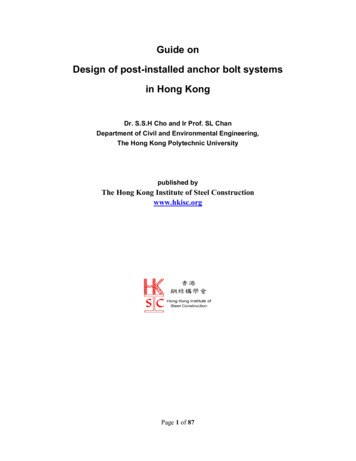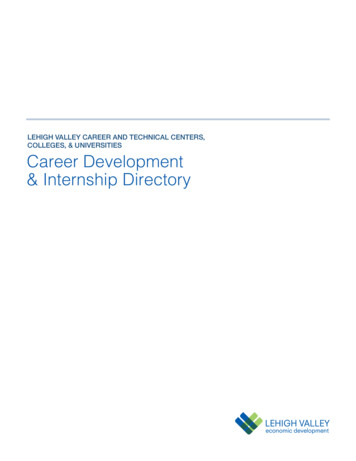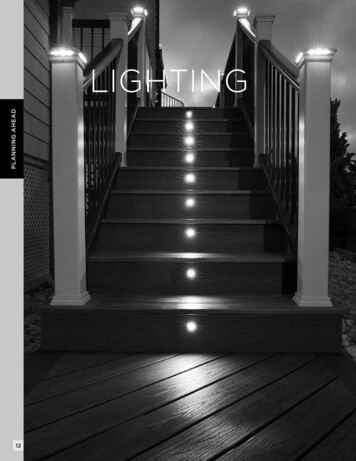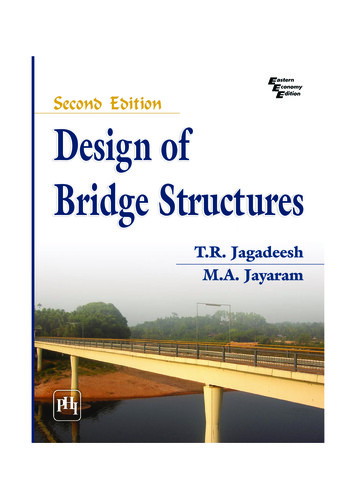
Transcription
Guide onDesign of post-installed anchor bolt systemsin Hong KongDr. S.S.H Cho and Ir Prof. SL ChanDepartment of Civil and Environmental Engineering,The Hong Kong Polytechnic Universitypublished byThe Hong Kong Institute of Steel Constructionwww.hkisc.orgPage 1 of 87
Contents1 Introduction . 61.1Scope of this book . 61.2Aim of anchor bolt design . 71.3Limit state design . 71.4Resistance and load factors. 81.4.1Resistance factors. 81.4.2Load factors . 91.52Anchor Bolts and Base Materials . 112.1Types of anchor bolts . 112.1.2Anchor bolts in a group . 13Base Materials. 152.2.1Concrete. 152.2.2Other base materials . 162.2.3Grout. 17Static analysis of anchor bolts . 183.1General . 183.2Tension force per anchor bolt . 183.2.1Fastenings subject to tension only . 193.2.2Fastenings subject to uni-axial bending moment only . 193.2.3Fastenings subject to tension and significant uniaxial bending moment213.34Anchor bolts. 112.1.12.23Major symbols . 9Shear force per anchor bolt . 213.3.1Shear force without lever arm. 253.3.2Shear force with lever arm. 25Failure modes and design resistance of mechanical anchors . 294.1General . 294.2Resistance to tension force . 30Page 2 of 87
4.2.1Steel failure . 304.2.2Pull-out failure . 314.2.3Concrete cone failure . 314.2.4Splitting failure . 374.354.3.1Steel failure . 384.3.2Concrete edge failure . 404.3.3Concrete pry-out failure . 454.4Resistance to combined tension and shear forces . 464.5Design procedure of mechanical anchor bolts . 46Failure modes and design resistance of chemical anchors . 485.1General . 485.2Resistance to tension force . 495.2.1Steel failure . 495.2.2Combined pull-out and concrete cone failure. 495.2.3Concrete cone failure . 515.2.4Splitting failure . 525.36Resistance to shear force . 38Resistance to shear force . 525.3.1Steel failure . 525.3.2Concrete edge failure . 525.3.3Concrete pry-out failure . 525.4Resistance to combined tension and shear forces . 525.5Design procedure of chemical anchor bolts . 52Seismic Design Consideration . 546.1General . 546.2Seismic performance categories . 546.3Design options . 556.3.1Design Option a1) – capacity design . 556.3.2Design Option a2) – elastic design . 566.3.3Design Option b) . 56Page 3 of 87
6.47Anchor Bolt Qualification. 617.1General . 617.2Anchor bolt assessment . 617.2.1Tests for suitability. 617.2.2Tests for admissible service conditions . 637.389Design resistance. 57Assessing the resistances of an anchor bolt . 65Design Examples . 678.12 2 anchor bolt group with tension and shear . 678.2Double anchor bolt group with shear and torsion . 728.32 2 anchor bolt group with shear and uniaxial moment . 76References . 82Appendix AA.1Installation Procedure . 83Installation procedure of mechanical anchor bolts . 83A.1.1Installation procedure of torque-controlled expansion anchor . 83A.1.2Installation procedure of displacement-controlled expansion anchor. 83A.1.3Installation procedure of undercut anchor . 83A.2Installation procedure of chemical anchor bolts . 84A.2.1Installation procedure of bonded anchor . 84A.2.2Installation procedure of bonded expansion anchor . 84Appendix BTesting of Anchor Bolts of Admissible Service Conditions . 85Page 4 of 87
PrefaceThis book is published by The Hong Kong Institute of Steel Construction for the benefitof the construction industry via technology advancement. The authors acknowledge thesupports by the Research Grant Council of the Hong Kong SAR Government on theprojects ” Second-Order Analysis of Flexible Steel Cable Nets Supporting Debris(PolyU 152008/15E)” and “Second-order and Advanced Analysis of Arches andCurved Structures (PolyU 152012/14E)” and the Innovative Technology Fund for theproject “Advanced design of flexible barrier systems by large deflectiontheory (ITS/032/14)”.DisclaimerNo responsibility is assumed for any injury and/or damage to persons or propertiesas a matter of liability, negligence or otherwise, or from any use or operation ofany methods, products, instructions or ideas contained in the material herein.Page 5 of 87
1 Introduction1.1 Scope of this bookAnchor bolts have been extensively used over the world for connecting steelstructures to concrete structures. They can be either cast-in or post-installed.However, in many cases, such as in Alteration and Addition (A&A) works in HongKong, the concrete has already been cast and set and therefore the anchor boltsare normally post-installed.In European countries, the European Organisation of Technical Assessment(EOTA) published the Guideline for European Technical Approval of Metal Anchorsfor Use in Concrete (ETAG 001) [1]. Anchor bolts which acquire EuropeanTechnical Assessments or formerly known as European Technical Approvals(ETAs) must fulfill the requirements given in ETAG 001 [1]. On the other hand, theEuropean Committee for Standardization (CEN) published Design of Fasteningsfor Use in Concrete (CEN/TS 1992-4) [2] which provides technical specificationson anchor bolt design which is based on the limit state approach.In Hong Kong, the authority provides a list of approved anchor bolts in the CentralData Bank (CDB) [3] which have been tested in accordance with outdated BS 5080[4] and ETAG 001 [1]. However, the current construction regulations do not providespecific design codes of anchor bolts so advanced system can hardly bedemonstrated to be sufficient. Instead of the limit state design approach, authoritieswidely accept using a global factor of safety of 3.0 to the characteristic resistanceof the anchor bolt to obtain its design resistance. This method has been adoptedfor decades and is considered obsolete and lack of transparency because the truefailure mode of the anchor bolt or the bolt group cannot be reflected. Therefore, adesign guide making references to latest technologies appears to be necessary.This handbook is aimed to set out the design guidelines for post-installed anchorbolt design subject to mainly static loads making references to ETAG 001, AnnexC [1], TR029 [5] and CEN/TS 1992-4 [2]. The design guidelines can be applied toboth single anchor bolts and bolt groups.This handbook shall be used in conjunction with the Code of Practice for theStructural Use of Steel [6] and the Code of Practice for Structural Use of ConcretePage 6 of 87
[7] or other relevant design codes for design of other steel elements such as baseplate or checking of existing structural elements which is not covered in thishandbook.1.2 Aim of anchor bolt designThe aim of anchor bolt design is to produce an anchor bolt connection analysis anddesign of adequate safety and serviceable level in its design life, both at asufficiently and acceptably low probability of violating the limit states. The anchorbolt connection should be fit for its purpose of construction during the design life ofa structure.1.3 Limit state designThe limit state design (LSD) was first introduced and became widely used aroundearly 80’s and it is aimed to make sure the factored resistance greater than factoreddesign load as: in which and(1.1)are respectively the load and resistance factors. The loadeffects, , shall be determined by normal structural analysis methods for axial,bending, shear or torsion and/or other actions in structural members andcomponents, multiplied by a partial load factor ( ) to give an upper bound estimatefor load effects. Resistance effects, , shall be determined by normal strength ofmaterials, geometry of member and other material properties. The material yieldstrength shall be divided by a resistance factor or partial material factor () to givea lower bound estimate for material properties.There are mainly two limit states, namely the ultimate and the serviceability limitstates. While this handbook covers mainly the ultimate limit state of strength, otherexamples of limit states relevant to steel structures are given in Table 1.1.Page 7 of 87
Table 1.1 Examples of limit statesUltimate limit states (ULS)Serviceability limit states (SLS)Strength (including general yielding,rupture, buckling and forming aDeflectionmechanism)Stability against overturning, sliding,Vibrationuplift and sway stabilityFire resistanceWind induced oscillationBrittle fracture and fracture caused byDurabilityfatigue1.4 Resistance and load factors1.4.1 Resistance factors1.4.1.1 Partial safety factor for steelThe partial safety factor of steelultimate strengthdepends on the characteristic steeland the characteristic steel yield strengthgalvanized steel as well as stainless steel, the value of. Forfor tension is givenby: 1.2 1.4For shear, the value of 1.0 1.25 1.5(1.2)is given by:forand 800N/mm2for 800N/mm2 orTherefore, as an example, for an anchor bolt with640N/mm2,the value of 0.8(1.3a) 0.8(1.3b) 800N/mm2 and is taken as 1.5 for failure modes due to tensionand 1.25 for failure modes due to shear.1.4.1.2 Partial safety factor for concreteThe partial factorcovers concrete break-out failure modes (i.e. cone failure,edge failure and pry-out failure).The value of is determined by: where partial factor for concrete under compression 1.5 partial factor taking into account the installation safety of thefastening systemPage 8 of 87(1.4)
For tension: 1.0 for systems with high installation safety 1.2 for systems with normal installation safety 1.4 for systems with low but still acceptable installation safetyFor shear: 1.0The level of installation safety can be found in the relevant approval documentsand depends largely on the anchor bolt size. For an anchor bolt with normalinstallation safety ( 1.2) as an example, the value ofis taken as 1.8 forfailure modes due to tension and 1.5 for failure modes due to shear.The partial factor for pull-out failureis given in the relevant approvaldocuments. In general, for the partial factors for splitting failurepull-out failure, the value forand theis recommended.1.4.2 Load factorsAs mentioned in Section 1.1, in Hong Kong, an overall factor of safety of 3.0 iswidely used in anchor bolt design. Since the required resistance factors varyamong different failure modes, the load factor will be given in Equation (1.5) sothat the overall factor of safety remains 3.0. 3.0(1.5)For example, if the anchor bolt design is governed by concrete cone failure with 1.5, the load factor will be given by 3.0 1.5 2.0.1.5 Major symbolsnormal force (positive tension, negative compression)shear forcemomenttorsion()characteristic resistance of normal force (shear force) of a singleanchor bolt or a bolt groupPage 9 of 87
()design resistance of normal force (shear force) of a singleanchor bolt or a bolt group()design normal force (shear force)edge distance from the anchor bolt centre( )edge distance in direction 1 (direction 2)characteristic edge distance for ensuring the transmission of thecharacteristic resistance of anchor boltminimum allowable edge distancediameter of anchor bolt or threaded diameteroutside diameter of anchor boltnominal diameter of drilled holecharacteristic compressive cube strength of concretecharacteristic steel yield strength or steel proof strengthcharacteristic steel ultimate strengthℎthickness of concrete in which the anchor bolt is installedℎeffective embedment depthℎminimum allowable thickness of concretenumber of anchor bolts in a groupcentre to centre spacing of anchor bolts in a group( )centre to centre spacing of anchor bolts in a group in direction 1(direction 2)characteristic spacing for ensuring the transmission of thecharacteristic resistance of anchor boltminimum allowable spacingPage 10 of 87
2 Anchor Bolts and Base Materials2.1 Anchor bolts2.1.1 Types of anchor boltsTo suit different needs and the conditions of the base materials, there are manytypes of anchor bolts as shown in Figure 2.1 such as:(a) Torque-controlled expansion anchor (sleeve type and wedge type)(b) Deformation-controlled expansion anchor(c) Undercut anchor(d) Concrete screw(e) Chemical anchor(f) Expansion chemical anchorThe above anchors can be classified into two broad systems, namely themechanical systems and the chemical systems which will be explained brieflyin Section 2.1.1.1 and 2.1.1.2.(a1) Torque-controlled expansionanchor (sleeve type)(a2) Torque-controlled expansionanchor (wedge type)(b) Deformation-controlledexpansion anchor(c) Undercut anchor(d) Concrete screw(e) Chemical anchor(f) Expansion chemical anchorFigure 2.1 Different types of post-installed anchorsPage 11 of 87
In Hong Kong, generally design engineers shall use anchor bolts listed in theCDB [3] which were previously approved in other projects. Sometimes theseanchor bolts were approved with conditions which are shown in the “remarks /comments” column of the reference list table. Therefore, design engineers shalltake the remarks or comments into consideration in their design. Otherwise, ifanchors bolts not listed in the CDB [3] are used, test reports in accordance withBS 5080 [4] or ETAG 001 [1] shall be submitted to the Building Departments(BD) or other relevant authorities for approval. Anchor bolts are commonlyavailable in galvanized steel and stainless steel. If the anchor bolt applicationis exposed to external condition, such as fixings at external walls and canopies,stainless steel anchors shall be used.2.1.1.1 Mechanical systemsMechanical anchors include types (a), (b), (c) and (d). For torque-controlledanchor, the “sleeve” or the “wedge” of the anchor bolts will expand in the drilledhole through applying a torque. Similarly, for deformation-controlled anchor, the“sleeve” of the anchor bolt will expand through movement of an internal plug inthe “sleeve”. The tensile resistance of an expansion type anchor bolt isdeveloped by friction between the “sleeve” or “wedge” of the anchor bolt andthe base material.Undercut anchors develop mechanical interlock between anchor and basematerial. The undercutting can be achieved by a special drilling tool or by theanchor itself during installation. Then the expansion “sleeve” will fill theundercut hole and develop a tensile resistance.Concrete screws are screwed into pre-drilled holes by a special screwdriver.The threads will cut into the concrete and create mechanical interlock betweenscrew and concrete.2.1.1.2 Chemical systemsTypes (e) and (f) are chemical anchors also known as adhesive anchors orbonded anchors. A chemical anchor is an anchor placed into a hole in concretewith the gap between anchor and the concrete filled with a bonding compound.After the bonding compound is set, a tensile resistance is developed by meansof chemical interlock.An expansion chemical anchor works like a combination of chemical anchorPage 12 of 87
and expansion anchor. After the bonding compound is set, a torque is appliedand the bonding compound around the “sleeve” is split and creates additionalfriction between the “sleeve” and the concrete.2.1.2 Anchor bolts in a groupThe design guidelines of this handbook can also be applied to groups of anchorbolts. In this case, only anchor bolts of the same type and size shall beconsidered and the following conditions are satisfied.2.1.2.1 Bolt configurationsFigure 2.2 and Figure 2.3 show the configurations of post-installed anchor boltscovered in this handbook. The allowable configurations depend on whichdesign code the anchor bolt design is based on. If the anchor bolts aredesigned in accordance with ETAG 001, Annex C [1] for mechanical anchorsor TR029 [5] for chemical anchors, the bolt configurations shall follow Figure2.2. Figure 2.2(a) shows the allowable configuration of anchor bolts situated farfrom concrete edges for all loading directions or close to concrete edges fortension force only while Figure 2.2(b) shows the allowable configurations ofanchor bolts situated close to a concrete edge subject to shear force. If theanchor bolts are designed in accordance with CEN/TS 1992-4 [2], the boltconfigurations shall follow Figure 2.3. Figure 2.3(a) shows the allowableconfiguration of anchor bolts without hole clearance situated at all edgedistances; Figure 2.3(b) shows the allowable configurations of anchor bolts withhole clearance situated far from concrete edges and Figure 2.3(c) showallowable configurations of anchor bolts with hole clearance situated close to aconcrete edge.If the anchor bolt is too close to a concrete edge, it will be susceptible toconcrete edge failure. Therefore, in ETAG 001, Annex C [1], TR029 [5] andCEN/TS 1992-4 [2], bolt configurations for bolts close to edge will have a morestringent requirement. In the case of max 10ℎ , 60, onlyconfigurations with single anchor bolts or groups with two and four anchor boltsare accepted as shown in Figure 2.2(b) and Figure 2.3(c). Configurations otherthan those shown in Figure 2.2 and Figure 2.3 shall also be allowed based onengineering judgment or other design methods according to the manufacturers.Those methods shall be developed based on current design standards (e.g.ETAG 001, Annex C [1], TR029 [5], CEN/TS 1992-4 [2] and FIB [8]) andsupported by a series of test data.Page 13 of 87
(a) All loading directions, if anchors are situated far from edges or tensionforce only, if anchors are situated close to edges(b) Shear force, if anchors are situated close to an edgeFigure 2.2 Configurations allowed in ETAG 001, Annex C and TR029Page 14 of 87
(a) Anchor bolts without hole clearance, far from concrete edge(b) Anchor bolts with hole clearance, far to concrete edge(c) Anchor bolts with hole clearance, close to concrete edgeFigure 2.3 Configurations allowed in CEN/TS 1992-42.1.2.2 Minimum bolt spacing and edge distance requirementsDesign engineers shall refer to manufacturer design manual for minimum boltspacing requirementand minimum edge distance requirementwhichare normally determined by tests and mentioned in the relevant approvaldocuments.2.2 Base Materials2.2.1 ConcreteThe concrete structures shall be of normal weight concrete with grades rangingfrom C25 to C60 (i.e. characteristic cube strength of concrete ranging from25N/mm2 to 60N/mm2. For other concrete grades, Section 2.2.2 shall bePage 15 of 87
referred. Depending on the type of anchor bolts, the base concrete may becracked or non-cracked. Cracks exist in tension zone of concrete and will affectthe resistance of the anchor bolt. Non-cracked concrete may be assumed ifunder service load conditions the anchor with its entire anchorage depth islocated in non-cracked concrete (i.e. compression zone).According to CEN/TS 1992-4 [2], non-cracked concrete may be assumed if thefollowing equation is observed: (2.1)where stress in the concrete induced by external loads including fastenerloads (compressive stresses are negative) stress in the concrete due to restraint of intrinsic imposeddeformations (e.g. shrinkage of concrete) or extrinsic imposeddeformations (e.g. due to displacement of support or temperaturevariations). If no detailed analysis is conducted, assume 3.0N/mm2. admissible tensile stress for the definition of non-crackedconcrete. The recommended value is 0 N/mm2.As a conservative approach, cracked concrete shall be assumed for anchorbolt design if the condition of concrete is not known.2.2.2 Other base materialsThe following base materials are also common in practice but not covered inthis handbook.(a) Low strength concrete ( 25 N/mm2)(b) high strength concrete ( 60N/mm2)(c) Lightweight concrete(d) Masonry(e) Brick wall(f) Drywall, etcThe characteristic resistances of anchor bolts in the above base materials shallbe determined by laboratory tests or based on engineering judgments. It isadvised to consult the manufacturers for design of anchor bolts in the abovebase materials.Page 16 of 87
2.2.3 GroutGrout is not a base material. However, it is commonly used as a levelling layer.The design strength of grout should be the same as for concrete of equivalentcube strengthbut greater than 30 N/mm2. The effect of grout as a levellinglayer will be described in Section 3.3.1.Page 17 of 87
3 Static analysis of anchor bolts3.1 GeneralA fastening can be subject to tension, compression, shear forces, moments, torsion,or the combination of above. These forces are resolved into shear and tension ofindividual bolts. Therefore, an anchor bolt can be subject to the following loadingconditions:(a) Tension force only(b) Shear force only(c) Combined tension and shearIn general, elastic analysis may be used for calculating the loads on individualanchor bolts both at ultimate and serviceability limit states.3.2 Tension force per anchor boltAccording to the theory of elasticity a linear distribution of strains across the baseplate and a linear relationship between strains and stresses exists (Figure 3.1).This assumption is valid only if the base plate is rigid and does not deformsignificantly. The base plate should remain elastic under design forces and itsdeformation should be compatible with the displacement of the anchor bolts.For the determination of forces of the anchor bolts the following assumptions maybe used:1. The axial stiffnessof all fasteners is equal. The anchor bolt threaded areashall follow the manufacturer specifications and the modulus of elasticity ofsteelshall follow the Code of Practice for the Structural Use of Steel [6] andis taken as 205 000 N/mm2.2. The modulus of elasticity of the concretedepends on the concrete gradeand shall follow the Code of Practice for Structural Use of Concrete [7].3. Anchor bolts in the zone of the base plate under compression do not take forces.The compression force is taken by the base plate and transferred to baseconcrete.The compressive stress in the concrete and the tension force in the anchor boltscan be solved by finding the neutral axis of the base plate under axial force andmoments. The neutral axis can be found by solving a cubic equation by numbersof iteration. Therefore, it is best to use design software to obtain the tension forcein the anchor bolts. However, under some simple loading conditions as in thePage 18 of 87
following sections, the tension forces of individual anchor bolts can be solved bysimple hand calculation.Figure 3.1 Stress-strain diagram of fastening under tension force andbending moment3.2.1 Fastenings subject to tension onlyIf the fastening is under tension only, the tension force of individual anchor boltscan be calculated simply by dividing the total design tension by the number ofbolts.3.2.2 Fastenings subject to uni-axial bending moment onlyIf the fastening is under uniaxial bending moment only as shown in Figure 3.2,the maximum design tension of single anchor bolt can be calculated by thefollowing steps.The stress-strain relationships of steel and concrete are respectively: (3.1) (3.2)From the strain diagram in Figure 3.2, the relationship between strain inconcrete and strain in anchor bolt is given by: Page 19 of 87(3.3)
The tension force of anchor bolts (and) and compression force at concrete( ) can be expressed below: 2 (3.4) (3.5)(3.6)2where modular ratio width of anchor plateAt equilibrium, 0( ) (3.7)( ) 23(3.8)After substituting Equations (3.4), (3.5) and (3.6) into Equation (3.7) andrearranging terms, Equation (3.7) can be rewritten as the following quadraticequation.2 2 (2 ) 0(3.9)Therefore, the location of neutral axis, , can be found by solving Equation (3.9).Onceis solved, the compressive strength of concrete and the anchor bolttension forces can be solved by substituting Equations (3.4), (3.5) and (3.6)back into Equation (3.8).Figure 3.2Fastening under uni-axial bending moment onlyPage 20 of 87
3.2.3 Fastenings subject to tension and significant uniaxial bending momentIf the fastening is under tension and a significant uniaxial bending moment, itis recommended that the design tension of anchor bolts should be solved bydesign software. Alternatively, it can be calculated by assuming the location ofthe neutral axis first. Then iterations are performed until the equilibrium of force( 0) and moment ( 0) is reached by shifting the neutral axis.3.3 Shear force per anchor boltIt should be noted that standard hole size should always be used; otherwise theanchor bolts are not considered to take up any shear force as only smalldeformation of fixture is assumed unless they are properly filled with mortar. Thecalculation of shear forces of individual anchor bolts depends very much on theirfailure modes.Figure 3.3 shows examples of shear force distribution under the failure modes ofsteel failure and concrete pry-out. If the fastening is subject to shear only as shownin Figure 3.3(a) and (b), the shear forces of individual anchor bolts are calculatedby dividing the design shear force by the number of anchor bolts. In case of torsionas shown in Figure 3.3(c), the sh
The aim of anchor bolt design is to produce an anchor bolt connection analysis and design of adequate safety and serviceable level in its design life, both at a sufficiently and acceptably low probability of violating the limit states. The anchor bolt connection should be fit for its purpose o











